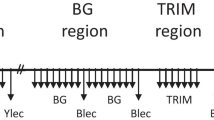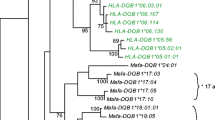Abstract
A C57BL/6By 5.5 kb Pvu II polymorphic restriction fragment which hybridizes with a spleen focus-forming env probe and maps in the H-30 region has been cloned, and a 358 by subfragment subcloned. Hybridization and sequencing studies show that the 358 by fragment is encoded by the region of the pol gene of murine retrovirus which codes for an endonuclease critical for viral integration. Hybridizations of digested murine genomic DNAs with the 358 by probe generate 31 restriction fragment length polymorphisms (RFLPs); 16 of these can be placed near the following 15 minor histocompatibility (H) loci: H-3, H-4, H-7, H-13, H-15, H-16, H-17, H-19, H-22, H-24, H-27, H-30, H-34, H-36, and H-38. We suggest that the proximity of viral sequences to H loci is probably evolutionarily and functionally significant and that the closeness of viral sequences and minor H loci can probably be utilized to facilitate the cloning of minor H genes. During the course of these studies, it has become possible to tentatively assign H-17, H-34, and H-38 to chromosome 12. In addition, it was observed that several H-2 congenic strains retain portions of chromosome 12 from the parental donor strains used in their derivation.
Similar content being viewed by others
References
Atherton, S. S., Streilein, R. D., and Streilein, J. W.: Lack of polymorphism for C-type retrovirus sequences in the Syrian hamster. In F. S. Ahmad, S. Black, J. Schultz, W. A. Scott, and W. J. Whelan (eds.): Advances in Gene Technology: Human Genetic Disorders, pp. 128–129, ICSU Press, Cambridge, 1984
Bailey, D. W.: Heritable histocompatibility changes: Lysogeny in mice. Transplantation 4: 482–487, 1966
Bailey, D. W.: Recombinant-inbred strains. An aid to finding identity, linkage, and function of histocompatibility and other genes. Transplantation 11: 325–327, 1971
Blatt, C., Berns, A., Nesbitt, M. N., and Simon, M. I.: Linkage of a preferential retroviral integration site Pim-1 to the histocompatibility complex in mice. In E. Skamene (ed.): Genetic Control of Host Resistance to Infection and Malignancy, Alan R. Liss, Inc., New York, in press, 1986
Blatt, C., Mileham, M., Hass, M., Nesbitt, M., Harper, M., and Simon, M.: Chromosomal mapping of the mink cell focus-inducing and xenotropic env gene family in the mouse. Proc. Natl. Acad. Sci. U.S.A. 80: 6298–6302, 1983
Breindl, M. and Jaenisch, R.: Conformation of Moloney murine leukemia proviral sequences in chromatin from leukemic and non leukemic cells. Nature 277: 320–322, 1979
Chan, H. W., Bryan, J., Moore, J. L., Staal, S. P., Rowe, W. P., and Martin, M. A.: Identification of ecotropic proviral sequences in inbred mouse strains with a cloned subgenomic DNA fragment. Proc. Natl. Acad. Sci. U.S.A. 77: 5774–5778, 1980
Chattopadhyay, S. K., Cloyd, M. W., Linemeyer, D. L., Lander, M. R., Rands, E., and Lowy, D. R.: Cellular origin and role of mink cell focus-forming viruses in murine thymic lymphomas. Nature 295: 25–31, 1982
Clark, S. P. and Mak, T. W.: Complete nucleotide sequence of an infectious clone of friend spleen focus-forming provirus: Gp55 is an envelope fusion glycoprotein. Proc. Natl. Acad. Sci. U.S.A. 80: 5037–5041, 1982
D'Eustachio, P.: A genetic map of chromosome 12 composed of polymorphic DNA fragment. J. Exp. Med. 160: 827–838, 1984
Donehower, L. A. and Varmus, H. E.: A mutant murine leukemia virus with a single missense codon in pol is defective in a function affecting integration. Proc. Natl. Acad. Sci. U.S.A. 81: 6461–6465, 1984
Godson, G. N.: Sequencing DNA by the Sanger chain termination method. In S. M. Weissman (ed.): Methods of DNA and RNA Sequencing, pp. 69–111, Praeger Publishers, New York, 1983
Groudine, M., Das, S., Neiman, P., and Weintraub, H.: Regulation of expression and chromosomal subunit conformation of avian retrovirus genomes. Cell 14: 865–878, 1978
Hayward, W. S. and Hanafusa, H.: Independent regulation of endogenous and exogenous avian RNA tumor-virus genes. Proc. Natl. Acad. Sci. U.S.A. 73: 2259–2263, 1976
Hayward, W. S., Neel, B. G., and Astrin, S.: Activation of a cellular one gene by promoter insertion in ALV-induced lymphoid leukosis. Nature 290: 475–480, 1981
Herr, W.: Nucleotide sequence of AKV murine leukemia virus. J. Virol. 49: 471–478, 1984
Herr, W., Corbin, V., and Gilbert, W.: Nucleotide sequence of the 3′ half of AKV. Nucleic Acids Res. 10: 6931–6944, 1982
Jaenisch, R.: Germ line and Mendelian transmission of exogenous type C viruses. In R. Weiss, N. Teich, H. Varmus, and J. Coffin (eds.): Molecular Biology of RNA Tumor Viruses, pp. 131–164, Academic Press, Inc., New York, 1980
Jaenisch, R. and Berns, A.: Tumor virus expression during mammalian embryogenesis. In M. Sherman (ed.): Concepts in Mammalian Embryogenesis, pp. 268–314, MIT Press, London, 1977
Jaenisch, R., Jahner, D., Nobis, P., Simon, I., Lohler, J., Harbers, K., and Grotkopp, D.: Chromosomal position and activation of retroviral genomes inserted into the germ line of mice. Cell 24: 519–529, 1981
Jenkins, N. A., Copeland, M. G., Taylor, B. A., and Lee, B.: Dilute (d) coat colour mutation of DBA/2J mice is associated with the site of integration of an ecotropic MuLV genome. Nature 293: 370–374, 1981
King, W., Patel, M. D., Lobel, L. I., Goff, S. P., and Nguyen-Huu, M. C.: Insertion mutagenesis of embryonal carcinoma cells by retroviruses. Science 228: 554–558, 1985
Lemay, G. and Jolicoeur, P.: Rearrangement of a DNA sequence homologous to a cell-virus junction fragment in several Moloney murine leukemia virus-induced rat thymomas. Proc. Natl. Acad. Sci. U.S.A. 81: 38–42, 1984
Li, Y., Holland, C. A., Hartley, J. W., and Hopkins, N.: Viral integration near c-myc in 10–20% of MCF 247-induced AKR lymphomas. Proc. Natl. Acad. Sci. U.S.A. 81: 6808–6811, 1984
McKenzie, I. F. C. and Potter, T.: Murine lymphocyte surface antigens: Adv. Immunol. 27: 179–338, 1979
Melvold, R. W. and Kohn, H. I.: Histocompatibility gene mutation rates: H-2 and non-H-2. Mutat. Res. 27: 415–418, 1975
Meruelo, D.: Retroviral sequences flanking histocompatibility genes alter their expression, function and evolution. A hypothesis. In E. Skamene (ed.): Genetic Control of Host Resistance to Infection and Immunity, Alan R. Liss, Inc., New York, in press, 1986
Meruelo, D., Offer, M., and Rossomando, A.: Induction of leukemia by both fractionated x-irradiation and radiation leukemia virus involves loci in the chromosome 2 segment coding for H-30 — Agouti. Proc. Natl. Acad. Sci. U.S.A. 80: 462–466, 1983a
Meruelo, D., Rossomando, A., Offer, M., Buxbaum, J., and Pellicer, A.: Association of endogenous viral loci with genes encoding murine histocompatibility and lymphocyte differentiation antigens. Proc. Natl. Acad. Sci. U.S.A. 80: 5032–5036, 1983b
Meruelo, D., Kornreich, R., Rossomando, A., Pampeno, C., Mellor, A. L., Weiss, E. H., Flavell, R. A., and Pellicer, A.: Murine leukemia virus sequences are encoded in the murine major histocompatibility complex. Proc. Natl. Acad. Sci. U.S.A. 81: 1804–1808, 1984
Murphy, M. R.: Natural history of Syrian golden-hamster. Reconnaissance expedition. Am. Zool. 11: 632–635, 1971
Neel, B. G., Hayward, W. S., Robinson, H. L., Fary, J., and Astrin, S. M.: Avian leukosis virus-induced tumors have common proviral integration sites and synthesize discrete new RNAs: Oncogenesis by promoter insertion. Cell 23: 323–344, 1981
Noori-Daloii, M., Swift, R. A., Kung, H. J., Crittenden, L. B., and Witter, R. L.: Specific integration of REV provirus in avian bursal lymphomas. Nature 294: 574–576, 1981
Nusse, R. and Varmus, H. E.: Many tumors induced by the mouse mammary tumor virus contain a provirus integrated in the same region of the host genome. Cell 31: 99–109, 1982
Nusse, R., van Ooyery, A., Cox, D., Fung, Y. K. T., and Varmus, H.: Mode of proviral activation of a putative mammary oncogene (int-1) on mouse chromosome 15. Nature 307: 131–136, 1984
Panganiban, A. and Temin, H. M.: The retrovirus pot gene encodes a product for DNA integration: Identification of a retrovirus tint locus. Proc. Natl. Acad. Sci. U.S.A. 81: 7885–7889, 1984
Pease, L., Schulze, D., Pfaffenbach, G., and Nathenson, S.: Spontaneous H-2 mutants provide evidence that a copy mechanism analogous to gene conversion generates polymorphism in the major histocompatibility complex. Proc. Natl. Acad. Sci. U.S.A. 80: 242–246, 1983
Reddy, E. P., Smith, M. J., and Srinivasan, A.: Nucleotide sequence of Abelson murine leukemia virus genome: Structural similarity of its transforming gene product to other one gene products with tyrosine-specific kinase activity. Proc. Natl. Acad. Sci. U.S.A. 80: 3623–3627, 1983
Schwartz, D. E., Tizard, R., and Gilbert, W.: Nucleotide sequence of Rous sarcoma virus. Cell 32: 853–869, 1983
Schwartzberg, P., Colicelli, J., and Goff, S. P.: Construction and analysis of deletion mutations in the pol gene of Moloney murine leukemia virus: A new viral function required for productive infection. Cell 37: 1043–1052, 1984
Shinnick, T. M., Lerner, R. A., and Sutcliffe, J. G.: Nucleotide sequence of Moloney murine leukemia virus. Nature 293: 543–548, 1981
Southern, E.: Detection of specific sequence among DNA fragments separated by gel electrophoresis. J. Mol. Biol. 98: 503–518, 1975
Southern, E.: Gel electrophoresis of restriction fragments. Methods Enzymol. 69: 152–176, 1980
Streilein, J. W., Duncan, W. R., and Homburger, F.: Immunogenetic relationship among genetically defined inbred domestic Syrian hamster strains. Transplantation 30: 358–361, 1980
Tsichlis, P. N., Strauss, P. G., and Fu Hu, L.: A common region for proviral DNA integration of MoMuLV-induced rat thymic lymphomas. Nature 302: 445–449, 1983
van der Putten, H., Quint, W., Verma, I. M., and Berns,A.: Moloney murine leukemia virus-induced tumors: Recombinant proviruses in active chromatin regions. Nucleic Acids Res. 10: 577–592, 1982
Weiss, E., Golden, L., Zakut, R., Mellor, A., Fahrner, K., Kvist, S., and Flavell, R.: The DNA sequence of the H-2K b gene: Evidence for gene conversion as a mechanism for the generation of polymorphism in histocompatibility antigens. EMBO J. 2: 453–462, 1983
Wejman, J., Taylor, B., Jenkins, N., and Copeland, N. G.: Endogenous xenotropic murine leukemia virus related sequences map to chromosomal regions encoding mouse lymphocyte antigens. J. Virol. 50: 237–249, 1984
Author information
Authors and Affiliations
Rights and permissions
About this article
Cite this article
Rossomando, A., Meruelo, D. Viral sequences are associated with many histocompatibility genes. Immunogenetics 23, 233–245 (1986). https://doi.org/10.1007/BF00373018
Received:
Issue Date:
DOI: https://doi.org/10.1007/BF00373018




